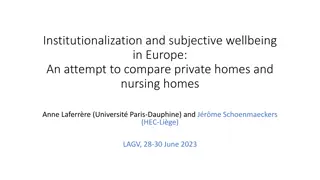Cultural Contrasts in Subjective Well-Being: Factors and Values
Societies exhibit varying levels of well-being influenced by factors such as wealth, stability, and culture. Economic development, social stability, and individualist-collectivist values play crucial roles. Broad socioeconomic indicators like GDP and life expectancy impact well-being significantly. Addressing severe poverty and harsh climates are essential to enhance subjective well-being globally.
Download Presentation

Please find below an Image/Link to download the presentation.
The content on the website is provided AS IS for your information and personal use only. It may not be sold, licensed, or shared on other websites without obtaining consent from the author.If you encounter any issues during the download, it is possible that the publisher has removed the file from their server.
You are allowed to download the files provided on this website for personal or commercial use, subject to the condition that they are used lawfully. All files are the property of their respective owners.
The content on the website is provided AS IS for your information and personal use only. It may not be sold, licensed, or shared on other websites without obtaining consent from the author.
E N D
Presentation Transcript
Cultural Differences in Subjective Well-Being
Why do societies differ in well- being? The contrast between Northern Europe and Africa draws attention to the importance of economic development and sociopolitical stability. Indeed, societies that are characterized by greater wealth and social stability have higher average levels of life satisfaction than those faring less well on these factors.
Broad socioeconomic factors such as per capita gross domestic product (GDP), life expectancy, and perceived corruption collectively account for 20% to 75% of the variance. Levels of well-being are higher in economically developed nations in part because people are better able to meet basic needs for food, comfort, and security. Citizens in wealthy countries also tend to experience greater freedom of choice and expression.
Severe poverty and harsh climates can reduce well-being by making it difficult for people to meet basic needs.
A person with high levels of SWB would ideally experience (1) positive emotions frequently, (2) negative emotions infrequently, and (3) evaluate their life as a whole as very satisfying.
We define culture as a system or pattern of beliefs, values, and practices shared and socially transmitted among people in a relatively enduring context.
Individualist-Collectivist Values It was conceptualized that individualism and collectivism are two major cultural patterns ( syndromes ) that differ in the extent to which the individual (versus one s in- group) serves as the primary reference for thought, feelings, and behavior.
Individualist-Collectivist Values Individualist cultures emphasize personal goals over in- group goals; behavior is based primarily on one s personal attitudes and preferences. Collectivist cultures emphasize in- group goals over personal goals; behavior is based primarily on in- group norms.
Individualist-Collectivist Values It was suggested that child- rearing practices tend to support the dominant cultural syndrome. Individualist cultures emphasize independence, exploration, creativity, and self- reliance. Collectivist cultures emphasize conformity, obedience, security, and reliability.
Self- Construal Cultures differ in the aspects of the self that are most salient to the individual. For example, it was proposed that Western cultures cultivate an independent self-construal that views the self as an autonomous entity, distinct and separable from others. The independent self consists of a unique configuration of personal attributes that is stable across situations.
Self- Construal In contrast, many non- Western cultures cultivate an interdependent self- construal that views the self as an entity that is fundamentally connected to others and contextually embedded. The interdependent self is organized with reference to how others in a relationship are thinking, feeling, and behaving; it consists of multiple configurations of personal attributes that shift according social roles.
Relational Beliefs A few studies have tested beliefs about one s relationship with others as mediators of cultural differences in well- being. These include the extent to which one is fulfilling parental expectations or feels responsible for the happiness of others.
Cultural Differences in SWB Past research emphasized the independence of positive affect (PA) and negative affect (NA) suggesting that the experience of PA and NA were unrelated. Some scales measure how often emotions are felt (frequency); others measure how strongly they are felt (intensity).
Cultural Differences in SWB Nevertheless, the inverse relation between PA and NA varies across nations, indicating that the degree to which emotional experiences are uniformly positive or negative may depend on cultural context.
Cultural Differences in SWB Cultural differences in the relation between PA and NA may be influenced by levels of individualism- collectivism. Western cultures tend to be more individualistic, and the negative correlation between PA and NA is stronger in individualist (versus collectivist) nations.
Mean Levels of SWB In most societies around the world except those marred by extreme poverty and social instability people report levels of well- being that are slightly above neutral, implying that most people are at least mildly happy . Still, there is considerable cultural variation in average levels of SWB.
Mean Levels of SWB East Asians often report lower levels of SWB than Westerners. These differences have been attributed to individualism- collectivism. Individualist countries tend to report higher levels of SWB than collectivist countries even after controlling for national wealth.
Mean Levels of SWB However, the exact process by which individualistic values influence mean levels of SWB remains unclear. It was suggested that individualist cultures promote and facilitate greater autonomy for people to pursue their personal goals. Individualist countries offer greater protection for the rights and liberties of their citizens.
Mean Levels of SWB Although greater autonomy and freedom are associated with higher levels of well- being, researchers have not formally tested it yet. One explanation can be that those with an independent self- construal might feel free to express their internal attitudes and feelings or pursue their personal interests. In contrast, those with an interdependent self- construal may feel more restricted because they are often be guided by a consideration for the reaction of others.
Mean Levels of SWB Parallel to this, compared with US participants, for instance, Taiwanese participants tended to rate their self- worth as more contingent on the approval of others. Compared with European American students, (1) Asian American students reported that their parents had more specific expectations; (2) the more specific expectations were, the less likely students felt they were fulfilling them; and (3) lower perceived fulfillment was associated with lower LS.
Mean Levels of SWB Indecision may also have negative effects on SWB because more effort is expended on making the decision and even after it is made, one is less likely to be satisfied. East Asians Canadians reported higher levels of chronic indecisiveness, and lower levels of LS compared to European Canadians.
Mean Levels of SWB East Asian Canadians were less satisfied than European Canadians in part because their greater tolerance for contradiction.
Mean Levels of SWB Culture also influences individuals in terms of attempting to increase (up- regulate) or decrease (down- regulate) the frequency, intensity, or duration of certain emotions. In a study, students rated their emotions twice: just after learning their grade on an exam and again the following day.
Mean Levels of SWB Among those who did well on the exam, European Americans maintained their PA the next day to a greater extent than Asians.
Correlates of SWB Several studies have reported cultural differences in the correlates of SWB. Examples include self- esteem, relationship harmony, self- consistency, emotion regulation.
Correlates of SWB Self- Esteem Though self- esteem is generally associated with greater SWB, the magnitude of this relation varies across cultures. Correlations between self-esteem and LS tend to be larger in Western samples than in East Asian samples.
Correlates of SWB One explanation is that Westerners tend to possess an independent self- construal in which unique traits and abilities are defining elements of the self. In contrast, East Asians tend to possess an interdependent self- construal in which social roles and obligations are more salient than individual attributes.
Correlates of SWB Thus, self-esteem should be highly desirable in individualist cultures as an indicator that one has successfully distinguished oneself from others. Indeed, when individualism is specifically examined (instead of East- West regional differences), self- esteem and LS correlate more strongly in individualist than in collectivist societies.
Correlates of SWB Relationship Harmony Harmonious relationships are critical in a culture in which one is dependent on and prioritizes the needs of one s in- group. Several studies have found that relationship harmony and attaining goals that made close others happy were more consistently associated with SWB for Asians and Asian Americans than for European Americans.
Correlates of SWB Self- Consistency A person who is equally kind to friends, family, and strangers is more self- consistent than one who is only kind to friends. Self- consistency was a much stronger predictor of SWB for US participants than for Korean participants.
Correlates of SWB These differences might reflect different cultural goals and affordances. For example, individualist cultures encourage and enable consistency by valuing the needs and interest of the individual. Collectivist cultures, on the other hand, prioritize the needs and interest of one s in- group. Because the in- group can shift in salience (e.g., friends, family, work colleagues) adaptability rather than consistency may be valued more in collectivist cultures.
Correlates of SWB Emotion Regulation The tendency to reappraise events in a more positive or less negative manner is positively associated with LS, Whereas the tendency to suppress emotional expression is negatively associated with LS. However, the negative effects of emotional suppression may not generalize across culture.
Correlates of SWB For example, when Japanese and American participants watched a stressful film with an experimenter present, Japanese participants tended to smile more than Americans. No cultural difference was observed when participants watched the fi lm alone: Both groups expressed negative emotion.
Correlates of SWB It was suggested that Japanese may have been masking their negative emotions when the experimenter was present. The controlled expression of emotion may facilitate the goals of an interdependent self (e.g., maintaining social harmony).
Additional Issues, Limitations, and Future Directions Measurement Issues When scales are translated into different languages, there is a risk that the meaning of an item is altered. Very often, translated measures are back- translated into the original language to check that meaning has been retained.
Additional Issues, Limitations, and Future Directions Responses to the five- item Satisfaction with Life Scale were examined across 41 nations. In most countries, the concept of life satisfaction may be similarly understood across cultures. However, responses were less consistent in poorer countries which could reflect a lack of familiarity with responding to survey items.
Additional Issues, Limitations, and Future Directions Response styles are another potential threat to the validity of cross- cultural comparisons. There is a tendency for East Asian participants to select the midpoint of the scale, whereas North American participants were more likely to give extreme responses.
Additional Issues, Limitations, and Future Directions Identifying the Mechanisms Underlying Cultural Differences in SWB There is a need for studies that identify the active cultural ingredients or mediators underlying group differences in psychological processes.
Additional Issues, Limitations, and Future Directions Second, other elements of culture can be investigated as mediators. For instance, the types of emotions that people desire to feel (ideal affect) vary across cultures. Whereas European Americans tend to desire high- arousal PA (e.g., enthusiasm), Hong Kong Chinese tend to desire low- arousal PA.
Additional Issues, Limitations, and Future Directions Cultural differences in ideal affect (i.e., what people want to feel) may underlie differences in actual affect (i.e., the emotions people actually feel) by influencing the way people regulate their emotions. For example, prolonged happiness was less desirable among Asian students than European American students.
Additional Issues, Limitations, and Future Directions Third, we have largely focused on values, self- construals, and beliefs. Nevertheless, cultural practices the way people actually behave and interact in a society may also mediate group differences in SWB. For example, child- rearing practices emphasize self- enhancement in the US but self- criticism in Japan.
Additional Issues, Limitations, and Future Directions Whereas European American mothers may try to cultivate their child s self- esteem, Japanese mothers may draw attention to their child s shortcomings.
Additional Issues, Limitations, and Future Directions East- West Differences Research on cultural differences in SWB draws heavily from comparisons of Easterners and Westerners. Almost 70% of the data come from European and North American nations, and 15% from Asian nations. Though we certainly need more well- being studies in Asia.
Additional Issues, Limitations, and Future Directions Thus the Asian and African regions are underrepresented in the current database on well- being. This imbalance reflects the longer history of population surveys conducted in the West.
Additional Issues, Limitations, and Future Directions Another issue is that although Latin America and Asia are thought to promote collectivist values and interdependent self- construals, average levels of SWB in many Latin American countries are higher than they are in Asia. Clearly there are important differences among Asian, Latin American, and African cultures, both within and between regions.
Additional Issues, Limitations, and Future Directions Operationalizing Culture Cross- cultural researchers have noted that cultural dimensions such as individualism- collectivism are meant to be descriptions of societies rather than individuals. Yet, cross- cultural psychologists often measure cultural values and self-construals by administering scales to individuals.
Additional Issues, Limitations, and Future Directions Are researchers studying culture or are they studying individuals with specific values and beliefs? For example, extraverted individuals are happier if they live in extraverted countries.
Additional Issues, Limitations, and Future Directions Other scholars have suggested that cultural differences may not always manifest in the values that people consciously endorse. the expression of cultural values and beliefs may be more implicit than is typically appreciated.
Additional Issues, Limitations, and Future Directions In one study, the definition of happiness in dictionaries from 30 nations was investigated. In the majority of nations (80%), happiness was defined as luck or fortune. However, SWB was higher in countries that defined happiness not as luck but as state of pleasure, satisfaction, or contentment. The authors suggested that, in countries where happiness is not viewed as luck, people may assume it is a state attainable through personal actions and decision- making.























